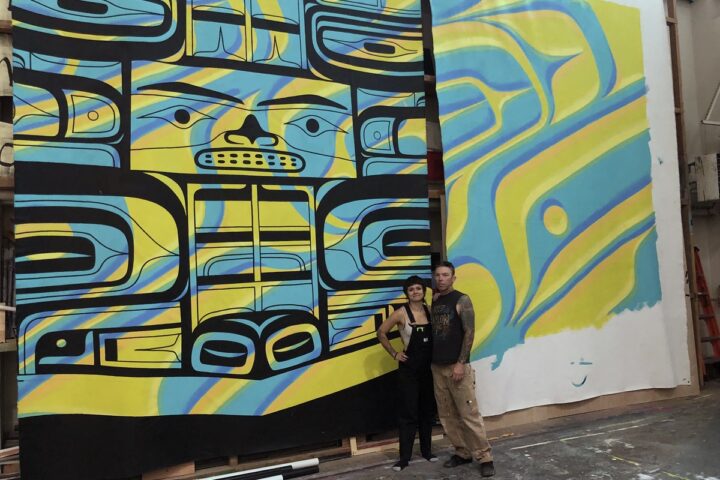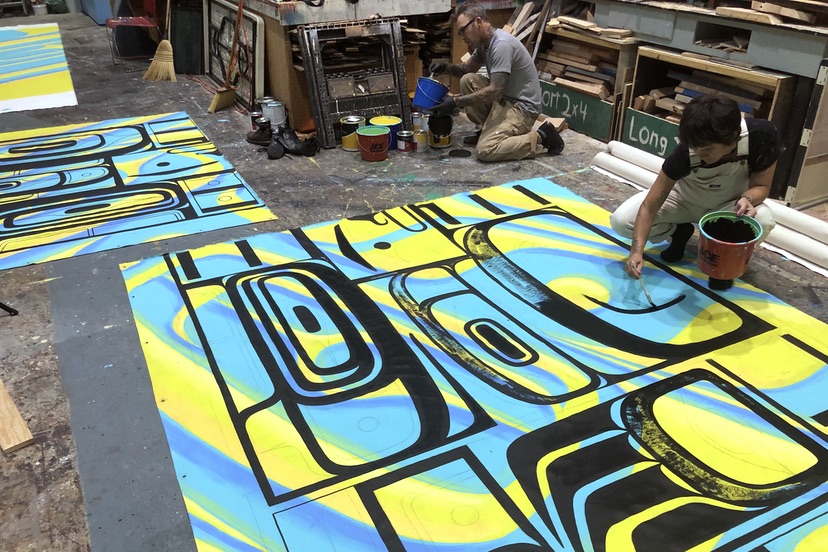PHOTO: Native artist Ursala Hudson applies black Chilkat Robe formlines to one of her smaller theatrical backdrops, while her husband Chris Haas prepares a bucket of paint.
WHAT IS ÁAK’W ROCK?
Shift your perspective of what you think Indigenous music sounds like and be immersed in a soundscape of Indigenous dreams, connection, and visions for our future. This is the essence and core of Áak’w Rock. It’s a three-day Indigenous music festival, held biennially on the ancestral homelands of the Lingít (People of the Tides) of the Áakʼw Ḵwáan (People of the Little Lake).
Áakʼw Ḵwáan Aaní (land) is also known as Juneau, Alaska…
— from the Áak’w Rock music festival website.
Waking up early on Wednesday morning, the Gastineau Channel and Mount Roberts — normally visible from the window in Lily’s guest bedroom — were hidden in a dense layer of fog. Also not visible: the four or five monstrous cruise ships that, during the summer tourist season, are typically docked at the Juneau, Alaska docks or anchored slightly offshore in the channel.
By late morning, the fog had burned off, but we didn’t notice, because we were inside the scene shop at Juneau-Douglas High School, painting large, painted backdrops for the upcoming Áak’w Rock music festival, scheduled for September 21-23, 2023 in Juneau.
My daughter Ursala Hudson had been commissioned to create the backdrops, and had enlisted members of the family — her husband Chris Haas, her sister Lily Hope, her daughter Amelie Haas (age 13), her nephew Nicholas Hope (age 15), and her father (me) — to help produce the works of background art.
Ursala is of Tlingit Indian heritage on her mother’s side. (I’m accustomed to spelling it, “Tlingit”, but apparently the organizers of Áak’w Rock prefer to spell the tribal name without the initial “T”. So, “Lingit”.)
Ursala’s designs combine traditional Chilkat Dancing Robe patterns, rendered in traditional black ‘formlines’… laid atop a highly abstracted (and brightly colored) Tlingit-influenced background.
The color pallet used in ancestral Tlingit art was quite limited by the available natural pigments and dyes — black, red and blue-green pigments for paint, and black, yellow, and blue-green dyes for yarns and fabrics.
Ursala used similar colors, but tweaked toward the psychedelic range, and then laid a traditional design over a wildly abstract design.
I don’t believe I’ve ever seen Northwest Coast Native art quite like it, except for one particular Chilkat robe designed by Ursala and woven by her sister Lily, plus a couple of innovative paintings done by Ursala’s late mother, Clarissa Rizal, in a similar style.

I lived in Juneau for about 20 years, from age 19 through age 41. My wife Clarissa and I were both artists, and both of us were fascinated by the highly stylized, traditional Native art of the Tlingit and Haida Indians. Clarissa eventually became one of the most respected weavers of Chilkat Dancing Robes and Ravenstail Dancing Robes, and she passed her love of weaving and traditional storytelling down to her two daughters.
You can learn more about Lily Hope, here.
You can learn more about Ursala Hudson (Kadusné), here.
Clarissa passed away in 2016.
A couple of months ago, I shared a story here in the Daily Post about Lily and Ursala, and a show at the Renwick Gallery in Washington DC.
Although Lily and her son Nicholas helped us with painting the Áak’w Rock backdrops, this was really Ursala’s project. She had designed the artwork (using her computer, as it turned out) and was the taskmaster and artistic director during the painting sessions.
The Áak’w Rock music festival will be presented by Tlingit and Haida Tribal Government; and Juneau Arts and Humanities Council. According to the Áak’w Rock website, it is “the only Indigenous music festival in the United States, and it showcases Indigenous music from around the world.”
From the website:
The festival provides reciprocity and protocol with the intention of honoring cultural existence, all the while rocking the stage.
“Protocol” and “honoring” are important cultural values among the Tlingit people. Love of rock music is a more recent development. Ditto, rap music.
Our space honors Indigenous creative expression and uplifts artistic practice. Genres are limitless and range from soul, rap, country, hip-hop, classical, and anything under the sun. The music is rooted in ancestral understanding, knowledge, respect, and values while breaking barriers and boxes of what it means to be an Indigenous artist and storyteller.
You could say that Ursala’s designs for the backdrops are also a form of ‘breaking barriers’.
We humans love protocol and traditional values. At the same time, we rely on our artists — musicians, visual artists, actors, dancers, writers — to push things beyond the ‘traditional’ to the next iteration.
Attending and supporting Áak’w Rock, together we create opportunities to overcome the historical under-representation of Indigenous performance. We are changing that narrative for our future by amplifying Indigenous excellence and voices to be heard for generations to come.

